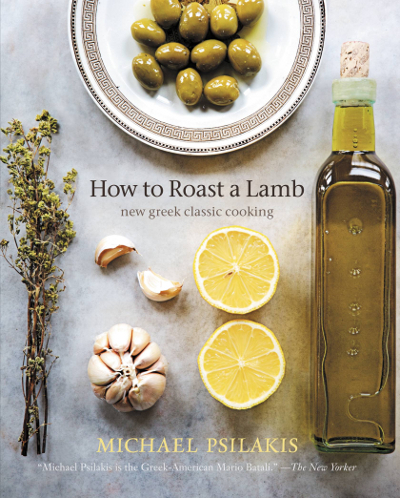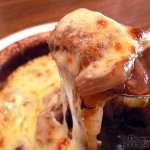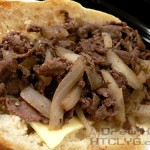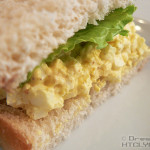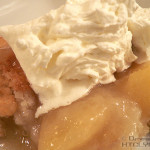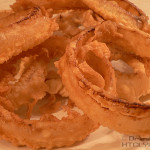When Little, Brown and Company sent me a copy of Michael Psilakis’ book How to Roast a Lamb: New Greek Classic Cooking, the first thing I noticed was that it’s way bigger than I’ve come to expect from celebrity chefs. Though you may not have heard of him, in the restaurant world Psilakis is definitely a celebrity on the way up, with three Manhattan restaurants getting rave reviews.
It became clear right away how this book was different. Psilakis is proud of his Greek heritage, and fills the book with stories from his life that illustrate how he came to his love of food. The most striking of these is when he tells how his father brought home a lamb weeks before Easter. A young Psilakis took care of the lamb for weeks, until the day his father butchered it in front of him.
As Psilakis cried over the loss of his “pet”, his father asked him where he thought food came from? He explained that killing an animal to eat it shouldn’t be taken lightly, and you should respect the animal in how you prepare it and eat it. This event lead directly to the offal dishes — entrails and organs — that Psilakis is known for. How can you slaughter an animal, then not eat every part of it?
Later, a recipe begins, “Decapitate the lamb.”
Needless to say, this is not a book for vegans.
Accessible, Everyday Recipes
The recipes are arranged not by ingredients or style, but grouped according to the period of Psilakis’ life where he first learned them: vegetable dishes from his father’s garden, seafood from days fishing with his father and uncles, family style dinners cooked by his mother, game he caught hunting with his father, birthday treats, party food, etc.
The earlier recipes are much more accessible to the home cook, based as they are on what his mother made for her family every day. But because Greek cooking is not as familiar in the U.S., the dishes still have an exotic flair, partly because they use ingredients we don’t see often.
The section introducing ingredients is fairly explicit about when you should spend extra for premium brands, and in some cases recommends specific brands. If you are trying Greek cooking for the first time, it makes sense to prepare the best version of it rather than skimp on ingredients and decide you don’t like it.
As the owner of a Michelen starred restaurant, Psilakis is not shy about calling for techniques that take a lot of time and effort. But at the same time he isn’t afraid to use the microwave when it’s the best tool, like for clarifying butter. So if he says it’s going to take a day to make a dish, you should plan for that whole day.
Restaurant Tips
Scattered throughout the recipes are tips from the restaurant world, like this one from his Steak with Bone Marrow Htipiti (Brizola me Htipiti Apo Medouli):
Here’s something steak houses don’t tell you: at most of them, there is a pot of rendered beef fat (all the trimmings and fat from the dry-aged beef). The cooks dip a steak into this fat before it’s cooked at superhigh heat, and then again afterward. Mmmmm.
Psilakis also describes the hardware they use, some of which — realistically — you’re not going to buy for home use. But very few of the recipes are out of reach of a well-stocked home kitchen.
Must-do Recipes
Of all the delicious sounding recipes, many illustrated with full-color photos that you should not look at when hungry (you have been warned), two stand out that I have to try.
The first is Pheasant with Spaghetti (Phasianos me Makaronia). The pheasant is braised with the typical aromatics — onion, grarlic, carrot, celery, thyme, sage, rosemary. Then you add some ingredients you don’t see in many American dishes — cinnamon, dates, raisins, dill, mint.
Toward the end, the dry spaghetti is cooked directly in the reduced braising liquid and served immediately, before the starch in the spaghetti thickens the sauce.
The other recipe that stood out is Grilled Quails with Sweet & Sour Charred Onion & Red Wine Glaze (Ortykia Stin Schara, Glykoxina Kremmydia Glassarismena me Kokkino Krasi — I think my spell-checker just had a heart attack). This one looks like a Greek version of barbecue, with raspberry, honey, bay and rosemary in the glaze.
Things That Make You Go Huh?
Not every recipe is a complete winner. The instructions for butchering a chicken are very explicit, but without photos of the process it’s hard to visualize. If you’ve done it before, his instructions are enough to complete the recipe, but if you haven’t … good luck.
And one recipe is just … I don’t know. It’s the Fried Pork & Beef Meatballs (Soutzoukakia). The first ingredient is “15 slices Wonder bread (crusts trimmed off)”. Really? Really? Wonder bread? This in the same book that warns, “You don’t want to destroy a dish you’ve worked on by compromising its integrity with inferior products.” If any product deserves to be called “inferior” it’s Wonder bread. Can you tell I’m not worried about pissing off sponsors?
Finally The Good Stuff
The second-to-last section finally has the recipes from Psilakis’ restaurants. And you can immediately see that this is not your everyday cooking. The ingredient list alone for the first recipe — Poached Halibut with Cypriot Shellfish Salad, Cucumber-Yogurt Broth & Caviar — runs more than a page.
The directions take another three pages. There are at least four steps I wouldn’t be confident in getting right on the first try, and two that require equipment you’re not likely to have. Although one of them offers a workaround you can do by propping your oven door open with a balled-up dish towel. No kidding.
These are the dishes with meticulous presentation we’ve come to expect from high-end cuisine. As he says in the introduction to the section:
In this chapter, we will be very specific — no more laissez-faire. The recipes in this chapter are ambitions and unapologetically restaurant-style, as they are a sampling from my restaurant Anthos.
As fun as the recipes are to read and look at, I think the closest I’ll come to most of these dishes is to take a trip to New York and have the staff at Anthos make it for me.
The Aegean Pantry
That’s the title of the last chapter, possibly my favorite in the whole book. Psilakis includes a host of tips for making the ingredients called for in his recipes: garlic confit and garlic purée; confits of chickpea, and fennel, and artichoke; zests and spice mixes and roasted vegetables; vinaigrettes and sauces; candied fruits and preserves.
Oh, one tip you’ll want to know sooner rather than later:
Using a Microplane zester, remove the zest from any quantity scrubbed and dried lemon or other citrus fruit — lime, orange, ruby-red grapefruit — without picking up any of the white pith. Spread the zest out on a baking sheet and place on a windowsill or any dry place. Let it dry overnight; all of the bitter oil in the skin evaporates and you are left only with concentrated lemon flavor.
Have you ever heard of drying lemon zest? Did you know it will eliminate the bitterness? This is my kind of tip. And the last chapter is full of them. I wish I could share them all.
The Giveaway
My bookshelf is already overflowing, so I’ve copied down the recipes and tips I wanted and I’m ready to pass along my copy of How to Roast a Lamb to someone else. If you’d like it, leave a comment below. (Include your email address so I can contact you if you win.) Post a tweet each day pointing to this page for another entry.
At 11 p.m. Eastern, Thursday, April 15th, I’ll pick a name at random to get the book.
Oh, and you you won’t get any more entries, but I’d appreciate if you’d go check out the recipe cards I’m doing. The first set goes out in just a couple weeks. Order now to make sure you don’t miss any.
